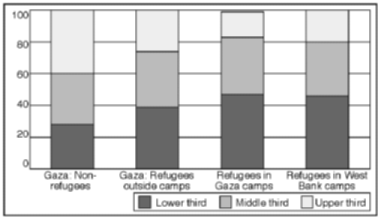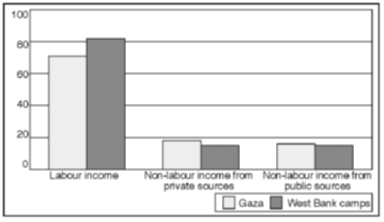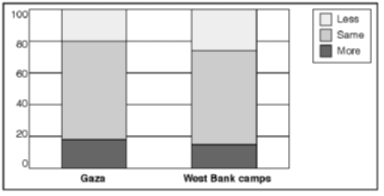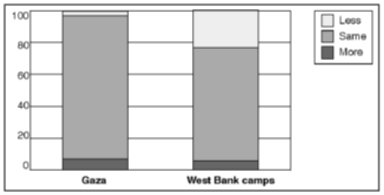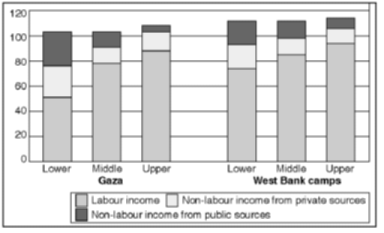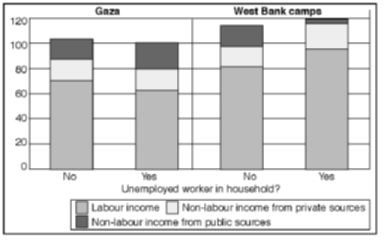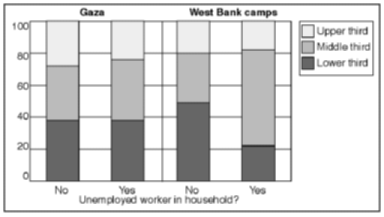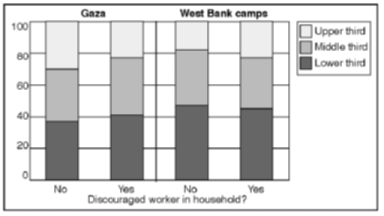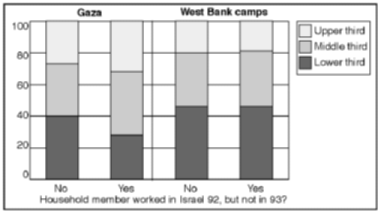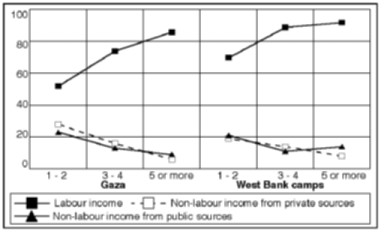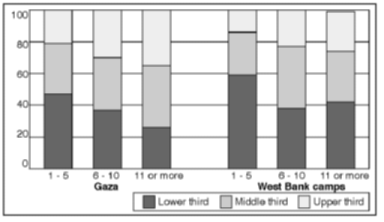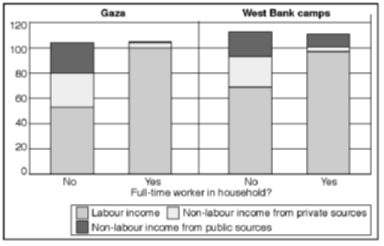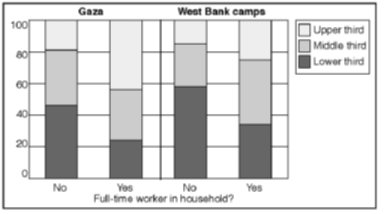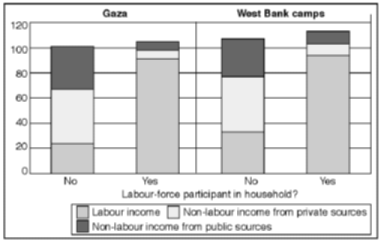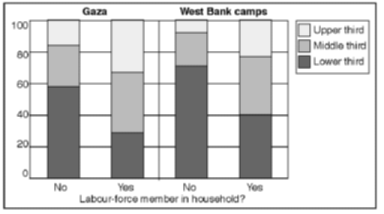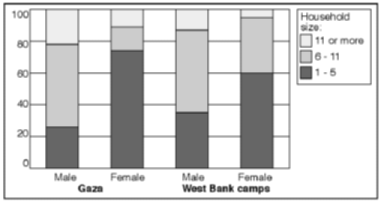
|
|||||||||||||||||||||||||||||||||||||||||||||||||||||||||||||||||||||||||||||||||||||||||||||||||||||||||||||||||||||||||||||||||||||||||||||||||||||||||||||||||||||||||||||||||||||||||||||||||||||||||||||||||||||||||||||||||||||||||||||||||||||||||||||||||||||||||||||||||||||||||||||||||||
|
(Chapter 3) Household income types and employment See table 3.19 to 3.41 in appendix 4 for references to this section. This section will investigate the relationship between types of household income, the index for household possession of consumer durables and employment within the household context. We are especially interested in seeing whether an explanation of the seemingly low downward shift of worker reservation wages may be found in the household's system for re-distributing economic resources among its members. We begin by presenting two of the main devices to be used in the discussion: the index for household possession of consumer durables, and the classification system for household income types. The index for household possession of consumer durables Measuring economic resources is problematic in most countries. First, the popular understanding of the concept "income" is usually far more narrow than definitions used by social scientists. In particular, women's and children's work tend to be neglected in most developing countries. Second, fear of taxation and lack of trust in national and local authorities lead to scepticism towards strangers asking about economic affairs. The result is intentional under-reporting and concealment of assets. In the Occupied Territories, the problem of under-reporting of economic resources is reinforced by two factors. First, as these areas are under military occupation, public trust in local authorities is close to naught. Second, the relatively large number of local and foreign organizations providing material support to the population encourages under-reporting of actual economic resources. To cope with the measurement problems likely to occur if crude questions asked about household income, we chose to take household wealth as the principal point of reference for measuring differences in household economic resources, as in FALCOT 92. Most items included in the index for household possession of consumer durables are verifiable, which reduces the problem of memory problems and under-reporting. The residual character of wealth, leading to greater variation in household wealth than in household income, makes it useful as an indicator for identification of households which suffer economic deprivation. Finally, because household wealth is less vulnerable to short-term economic fluctuations than various kinds of income, one could argue that it largely reflects the distribution of economic resources in the households in the sample prior to the border closure, thus providing a baseline for subsequent changes. Resembling the approach used in FALCOT 92, the index for possession of consumer durables divides the households in Gaza and the West Bank refugee camps into three equal-sized groups, yielding a low, a middle and a high wealth group. In contrast to FALCOT 92, this index for possession of consumer durables is based on a simple addition of a household's consumer durables and other items. A region or socio-economic group may be characterized as "under-privileged, relative to the survey population on average, when its proportion of households in the lowest wealth group exceeds 1/3 and its proportion in the upper wealth group is less than 1/3. It is worth emphasizing that even if this index for possession of consumer durables allows a ranking of households according to wealth, it does not aspire to measure the absolute level of household economic resources or economic deprivation for any region or socio-economic group. This means that absolute measures of economic deprivation, such as "poverty lines", cannot be constructed on the basis of this index. Furthermore in contrast to FALCOT 92, the 1993 index for possession of consumer durables is constructed exclusively from the sample of households in Gaza and the West Bank refugee camps. It thus presents the relative distribution of wealth in these areas, not in the Occupied Territories as a whole. This point is particularly important because the low score of Gaza and the West Bank refugee camps in the FALCOT 92 index for possession of consumer durables was the principal reason for conducting the FALUP survey in these areas. Household wealth is accumulated over time, and is thus less vulnerable to sudden changes in the economic environment than income. Despite the border closure, we would expect only relatively minor short-term changes in the relative distribution of wealth across regions and socio-economic groups. And indeed, the relative distribution of the 1993 index for possession of consumer durables seems to correspond roughly to the findings of FALCOT 92, taking into consideration differences in the base population and the construction of the two indices. Figure 3.11 presents the distribution of the 1993 the index for household possession of consumer durables by Gaza refugee status and for the West Bank refugee camps.
Figure 3.11 1993 index for household possession of consumer durables, by refugee
status. Percentage of all households in respective groups For the 1993 sample, the highest household score is found among Gaza non-refugees. Gaza refugees outside camps score clearly below non-refugees, but still higher than camp refugees in both Gaza and the West Bank. A possible explanation for this last finding is that refugee households that rich, can afford to prefer to move out of the camps. While regional variations within Gaza seem to be correlated with variations in refugee status and type of locality, no significant regional variation was found among the West Bank refugee camps. We have not applied a conventional rural-urban classification of localities, because the Gaza Strip is highly urbanized. The distribution of the index for household possession of consumer durables with regard to individual characteristics of the head of household like age and education is similar to findings from FALCOT 92 and will consequently not be further discussed here. In FALCOT 92 only the prevalence of various types of household income was recorded. FALUP 93 included more income types, and respondents were also asked to assess the relative importance of the various types, as well as any changes since 1992. We are particularly interested in the income types of households where members face employment problems after the closure. No attempts have been made to record exact levels of household income. As already noted, absolute measures of economic deprivation such as a "poverty line" can consequently not be constructed. Our working hypothesis, the "family employment network" hypothesis, is that individuals with employment problems primarily rely on the labour activity of other household members for economic support. The reservation wage of unemployed and discouraged workers must thus be assumed to depend largely on the labour activity of other household members. The "family employment network" hypothesis will be further examined below. First let us present the regional pattern of income types in the sample as of 1993. Second, some results concerning changes in income since 1992 will be discussed. Finally, we turn to the question of correlations between the various income types and the index for household possession of consumer durables. Prevalence and importance of household income types Table 3.1 presents the various types of income by main geographical area. For each socio-economic group, the upper rows illustrate the prevalence of various income types for all households in the group. The lower rows reflect the importance of various income types defined as the proportion of all households in the group where these types are of "main importance". (The sums of these proportions vary in the range 105-115% across different areas and socio-economic groups.) Table 3.1 Household income types, by main geographical area 1
For each type of income the relative difference between the two rows illustrates whether it is a primary or supplementary component in the household economy of that socio-economic group. Income types of "main importance" for less than half of the households in a particular group are defined as "supplementary" for that group. By far the most significant type of income, both with regard to prevalence and importance, is wages. Central and Southern Gaza have the lowest proportion of households receiving various types of labour income, a finding also made by FALCOT 92. The highest prevalence of wages is found in the Central/ Southern West Bank refugee camps, close to the relatively prosperous labour market in the Greater Jerusalem Area. Agricultural income has some importance in Gaza, but is, as could be expected, virtually absent in the densely crowded West Bank refugee camps. In Gaza, agricultural income and self- employment/ household production play a more important role for the non-refugee community than for refugees, probably because most agricultural land is owned by the original Gaza inhabitants. UNRWA support is, of course, received almost exclusively by refugee households. Because of the relatively high proportion of original inhabitants living in Greater Gaza City, geographical variations in UNRWA support can be explained mainly by differences in the regional proportions of the population constituted by refugees. Among the West Bank refugee camps, Northern camps have more business income, the highest proportion of households selling properties, and more persons receiving UNRWA support and zaqat money than the Southern/ Central camps. The Northern camps, however, receive less wages and social benefits. For social benefits, this is possibly because 20% of households in the Southern/ Central camps live in Jerusalem. The types of household income in table 3.1 can be crudely divided in three. The first, and generally most important group, is income from labour activity (in the Occupied Territories), especially in the form of wages. The second group is "non-labour" income from private sources, like pensions and remittances. This group also includes "other" income, even if such income in many cases refers to various kinds of casual work not reported in the questions about individual employment. The third group is non-labour income from public sources, like zaqat money and support from UNRWA and the Israeli Civil Administration. Except for income from home production/ self-employment, all types of labour income are "primary" components in the household economy. Non-labour income from both private and public sources generally has a "supplementary" character. All the same, as shown by figure 3.12, these two types of non-labour income were primary sources of income in approximately one third of the households in both main regions.
Figure 3.12 Household income types of main importance, by main geographical area.
Percentage of all households in respective groups Respondents were asked explicitly about changes in these income types since summer 1992, (i.e. the time of interviewing for FALCOT 92). However, many income types are received by so few households as to make it meaningless to construct any sub-division here. The March 1993 border closure in effect represented a negative shift in demand for labour; and this, according to economic theory, should lead to a reduction in both wages and the volume of employment. Being the product of these factors, a substantial decrease in income from labour activity should thus be expected. However, for all types of labour income, the majority of households in the sample reported "no change" in income since 1992. In the West Bank refugee camps there seem to have been a downward shift in wages, in particular in the Northern camps. In Gaza, on the other hand, the size of the group reporting more wages almost equals that reporting less wages. Figure 3.13 presents a regional overview of reported changes in wages from 1992 to 1993.
Figure 3.13 Changes in wages from 1992 to 1993, by main geographical area. Percentage
of households receiving wages in each area The pattern of changes in wages may in part reflect the fact that comprehensive restrictions on employment migration to Israel had troubled Gaza ever since the 1991 Gulf War, while the economic shock in the West Bank refugee camps occurred primarily after the March 1993 border closure. Still, the proportion of households reporting substantial downward shifts in labour income in Gaza from 1992 to 1993 is surprisingly small. Chapter 2 clearly documented the decrease in volume of employment from 1992 to 1993. Assuming that hourly wages have also declined, the lack of reported change in household income from wages may be due to a tendency among respondents to give the most "easy" / "neutral" answer: simply "no changes". It is difficult to find any systematic pattern of regional changes for non-labour income types from private and public sources. Remittances, which dropped substantially immediately after the Gulf War, still show a falling tendency in both main geographical areas. Social support from public organizations, (UNRWA and others) generally seems unchanged in Gaza, but displays a slightly falling tendency in the West Bank refugee camps, as illustrated by figure 3.14.
Figure 3.14 Changes in non-labour income from public sources, by main geographical area.
Percentage of households receiving non-labour income from public sources in groups Income types and the index for household possession of consumer durables Here we discuss the relationship between household wealth and the three main groups of family income. We are particularly interested in the relationship between non-labour income from public sources and household wealth. Are, for example, various social support arrangements from UNRWA, the Israeli Civil Administration, etc., received primarily by poor and presumably needy households? Figure 3.15 shows the relationship between household wealth and the three main groups of family income. If the proportion of households receiving one group of income types increases with household wealth, these income types may be said to be associated with high status.
Figure 3.15 Household income types, by index for possession of consumer durables.
Percentage of the income types reported as having "main importance" within respective
groups of households The proportion of households receiving labour income tends to increase with household wealth. For the dominant labour-income type wages the increase is particularly marked from the lowest to the middle wealth group. In Gaza, agricultural income is also associated with (relatively) high wealth. In dealing with household income-generating activities no indications were found that these activities had increased so as to compensate for lost income from formal employment, neither at the individual nor at the household level. If household income-generating activities had played a compensatory role, higher proportions of income from home production and self-employment could have been expected in the lower household wealth groups. Here we see that the proportion of households receiving income from home production and self-employment increases with household wealth, which confirms our findings in the section about household income-generating activities. The types of labour income most clearly associated with "high" household wealth are income from trade, industry and service establishments. Similar findings were made in FALCOT 92. This observation does, however, not necessarily reflect a favourable climate for such establishments in the Occupied Territories. Because of the virtual absence of non-personal financial institutions for capital supply, high wealth may be a pre-condition for starting up trade, industry and service establishments, rather than a result of such activity. Non-labour income types from private sources are somewhat over-represented in the lowest household wealth group. This is due largely to the high number of households in this group reporting "other income" as being of "main importance". This finding is in line with the observation that poor households usually pursue multiple economic strategies. Remittances and pensions are not found to be associated with any particular wealth group. As could be expected, the few households receiving rent revenues are over-represented in the upper wealth group. Sale of possessions is not particularly associated with the lowest wealth group, probably because the poorest households also have the fewest assets to sell. (Many household often have only a used fridge or radio). Are various social support arrangements from UNRWA, the Israeli Civil Administration, etc., received primarily by the poor and presumably needy households? For all three types of support, the proportion of recipient households decreases with increasing wealth. The only exception here is UNRWA support among households in the West Bank refugee camps. Also many households in the "highest" wealth group receive UNRWA support. However, this finding does not necessarily indicate "incorrect" priorities within the UNRWA support system. First, it should be remembered that all areas to be included in our survey population were selected on the basis of having below average scores (relative to the Occupied Territories) on the index for household possession of consumer durables in FALCOT 92. Second, the index is relative; belonging to the "highest" household wealth group does not necessarily imply a satisfactory level of material welfare for households in this group. Third, UNRWA runs various relief programmes. Some of them distribute support to all refugee households. Other programmes, like the "Special Hardship Cases", are means-tested and thus distribute support only to particularly needy refugee households. 2 Because we do not know the absolute level of support, the high proportion of households in the lowest wealth group relying on UNRWA support could be interpreted in quite different ways. "Main importance", being defined relatively to total household income, could on the one hand indicate that current support levels for the poorest households are high in absolute terms. On the other hand, it could indicate that these households receive so little other income that even low levels of UNRWA support constitute a major component of total household income for them. As a conclusive remark it should be stressed that figure 3.15 illustrate correlations between household income types and household wealth, and not necessarily casual relations which can take various directions. It is for example reasonable to assume that receiving wages, and hence holding employment, may yield a higher score on the index for household possession of consumer durables. Receiving economic support from UNRWA on the contrary, is obviously the condition for, rather than the reason behind, a low household wealth score. The "family employment" network hypothesis We will now proceed with the investigation of income types of households whose members face employment problems after the closure. The "family employment network" hypothesis stipulated that individuals facing employment problems primarily rely on the labour activity of other household members for economic support. The reservation wage level of unemployed and discouraged workers must thus to a large extent be assumed to depend on the labour activity of other household members. To test this hypothesis we have singled out three groups of households. First, households with at least one unemployed member. Second, households with at least one "discouraged worker". Third, and partially included in the two first groups, households where at least one member lost employment in Israel from 1992 to 1993. Neither figure 3.16 nor 3.17 seems to contradict the "family employment network" hypothesis. In the households with unemployed and discouraged workers, the majority rely primarily on labour income which must be assumed to stem from the labour activity of other household members.
Figure 3.16 Income types of main importance, by main geographical area and unemployed
worker in household. Percentage of all households in respective groups
Figure 3.17 Income types of main importance, by main geographical area and discouraged
worker in household. Percentage of all households in respective groups Non-labour income from public sources is not systematically more important in households with unemployed and discouraged workers than in other households. In the West Bank refugee camps, the proportion of households relying on non-labour income from public sources is even lower among households with unemployed and discouraged workers than among other households. These results do not lend support to claims that non-labour income from public sources for example, UNRWA is the main factor halting a decline in the reservation wages of unemployed and discouraged workers. Figures 3.18 and 3.19 provide further support to the "family employment network" hypothesis. In both main geographical areas the distribution of the index for household possession of consumer durables across households with unemployed and discouraged workers is hardly different from the distribution in other households.
Figure 3.18 Household index for possession of consumer durable, by main geographical
area and unemployed worker in household. Percentage of all households in respective groups
Figure 3.19 Household index for possession of consumer durable, by main geographical
area and discouraged worker in household. Percentage of all households in respective groups Because income from labour activity is the main source of income for these households. labour income from other household members seems to explain why (at least one) member(s) in these households can "afford" to stay unemployed, or be a "discouraged worker" while waiting for an "acceptable" job. The findings above are confirmed by figure 3.20 which shows income types of "main importance" in households where at least one member lost employment in Israel from 1992 to 1993. In both main geographical areas, more than 2/3 of this group of households rely on labour income as their primary source of income. Non-labour income from public sources seems even less important than among other households.
Figure 3.20 Income types of main importance, by main geographical
area and workers who lost employment in Israel in household. Percentage of
all households in respective groups Figure 3.21 shows no difference in the distribution of the index for household possession of consumer durables in households where at least one member lost employment in Israel from 1992 to 1993, as compared with other households. Here we should recall, however, that the index for household possession of consumer durables represents economic resources accumulated over time, and does not necessarily give an exhaustive picture of the post-closure economic situation.
Figure 3.21 Household index for possession of consumer durable, by main geographical
area and workers who lost employment in Israel in household. Percentage of all households
in respective groups Dependence on public support, employment and household wealth The previous section found no reason to reject the "family employment network" hypothesis, which suggests that individuals facing employment problems rely primarily on the labour activity of other members of the household for economic support. In households with one or more unemployed and "discouraged workers", we found no indications that non-labour income from public sources was more important than in other households, nor any sign that these households scored lower on the index for household possession of consumer durables. If the "family employment network" hypothesis holds, then the presence of other income-earners in the household is of critical importance for the economic welfare of those who lose employment. It seems reasonable to assume that the chances of other household members being employed are positively correlated with household size, and in particular increasing with the number of adult males, who constitute more than 90% of the labour force. Because the number of adult males, adult females and children in a household all are highly correlated, we have compared the importance of the main income groups across total household size. Figure 3.22 shows, as expected, that the importance of labour income tends to increase with the number of household members, whereas the importance of both private and public non-labour income decreases with household size. The positive correlation between labour income and household size is particularly marked for wages, and in Gaza also for agricultural income.
Figure 3.22 Household income types of main importance, by household size.
Percentage of all households in respective groups Household wealth clearly seems to increase with household size in both main geographical areas. Figures 3.23 show that particularly small households are over-represented in the lower, and under-represented in the upper wealth group.
Figure 3.23 Index for household possession of consumer durables, by household size.
Percentage of all households in respective groups Large households are thus less dependent on public support than small households are; financially, they rank above average as measured by the index for household possession of consumer durables. Summing up, large households form a private "social security system" on the micro-level, offering their members a kind of collective insurance against sudden economic shocks. The higher chance that at least one household member will be employed may help to explain why worker reservation wages do not seem to have fallen sharply after the border closure. Let us now turn to the role played by various types of non-labour income from public sources, and assess their importance for the different socio-economic groups. Highlighting the importance of employment for the (total) household economy, figure 3.24 demonstrates that households with at least one full-time employed member rely almost exclusively on labour income for survival. The role of non-labour income from public sources is consequently marginal here. Even though the labour force classification of household members refers to the week immediately prior to the survey, we may assume that most of the households with at least one full-time worker have been in this situation since before the border closure. Using the index for household possession of consumer durables to describe the relative economic position of households with at least one full-time worker, we find that the importance of stable labour activity is once more demonstrated (see figure 3.25.) Households with at least one full-time worker are under-represented in the lower, and over-represented in the upper wealth group.
Figure 3.25 Household index for possession of consumer durables, by main geographical
area and full-time worker in household. Percentage of all households in
respective groups The "family employment network" hypothesis cannot, of course, hold for households where all members are out of work. Here non- labour income from public sources seems likely to enter the picture. What kinds of income do these households rely on? (See table 3.2.) Table 3.2 Income types, by main geographical area and labour-force participant in household. Percentage of all households in respective groups
The classification "no labour force member" in table 3.2 refers to the last week prior to the survey, while prevalence and importance of income types refer to a somewhat longer time period, "at the time of the survey". The reason labour income still holds "main importance" in at least one fourth of the households with no labour-force members is thus (casual) labour activity among household members prior to the week in question. The high number of households receiving "other" income is in many cases also due to various kinds of casual work in the reference week, not reported in the questions about individual employment. Income from trade and business establishments, which tend to reflect more permanent employment, is virtually absent from the households with no labour-force members. Households without labour-force members do not rely more on sale of possessions than other households, probably because they own little in the way of salable goods anyway. A relatively high number of them are dependent on remittances, indicating that the household nevertheless lives off labour income, although provided by family members working abroad. In contrast to zaqat money and social benefits, there is little variation in the prevalence of households receiving UNRWA support. The importance of UNRWA support is, however, much greater in households without labour-force members than in other households, while zaqat money and social benefits seem to play a more supplementary role. Figure 3.26 sums up the importance of the three main groups of household income for households with and without labour-force members. We see that in both Gaza and West Bank refugee camps, households without labour-force members rely primarily on non-labour income from private sources. 3
Figure 3.26 Income types of main importance, by main geographical area and labour-force
participant in household. Percentage of all households in respective groups Even though two out of three households without labour-force members rely mainly on income originating from various private sources, it seems that it is difficult for private arrangements like family and other personal social support networks to cover the needs of all households in this situation. In the West Bank refugee camps three times, and in Gaza five times as many of these households rely mainly on public transfers like UNRWA support, social benefits and zaqat money than on private arrangements. As was the case with households with at least one full-time worker, we may also assume that many households without labour-force members have been in this situation for some time. Comparing how these households on the index for household possession of consumer durables with other households yields a picture quite the opposite as for households with at least one full-time worker. From figure 3.27 we see that in both main geographical areas households without labour-force members are over-represented in the lower, and under-represented in the upper wealth group.
Figure 3.27 The index for household possession of consumer durables, by main
geographical area and labour-force member in household. Percentage of all
households in respective groups Are there any other socio-economic groups where the family and social network system fails to provide sufficient mutual support among household members? Particularly vulnerable in this context seem to be households headed by women. This group scores very low on the index for household possession of consumer durables, particularly in Gaza (see figure 3.28).
Figure 3.28 The index for household possession of consumer durables, by main
geographical area and gender of head of household. Percentage of all households
in respective groups The "family employment network" hypothesis assumes that employment problems among household members are absorbed by the labour activity of other household members, at least to some extent. As shown by figures 3.29 and 3.30, households with female heads are, however, both small and frequently without any labour-force members at all.
Figure 3.29 Household size, by main geographical area and gender of head of
household. Percentage of all households in respective groups
Figure 3.30 Labour-force member in household, by main geographical area and gender
of head of household. Percentage of all households in respective groups Because of their small size and low labour activity, many female headed households to a large extent fall outside the private "social security system" formed by large households on the micro level. Instead they must often rely on public transfers for survival. In female-headed households in Gaza, the proportions of labour and non-labour income types having "main importance" are 29% and 75% respectively, whereas in male-headed households in Gaza, the corresponding proportions are 75% and 28%. Non-labour income from public sources like UNRWA support, social benefits and zaqat money are of "main importance" to only 12% of Gaza's male-headed households, but to as many as 47% of its female-headed households. Summing up household income types and employment We have found no reason to reject the "family employment network" hypothesis, which suggests that individuals facing employment problems rely primarily on the labour activity of other household members for economic support. In households with one or more unemployed and "discouraged workers", we found no indications that non-labour income from public sources is more important than in other households, nor any sign that these households score lower on the index for household possession of consumer durables. If the "family employment network" hypothesis holds, the presence of other income earners in the households is of critical importance for the economic welfare of those who lose employment. This makes large households less dependent on public support than small households, and place them economically above average as measured by the index for household possession of consumer durables. Large households seem to form a private "social security system" on the micro level, offering their members a kind of collective insurance against sudden economic shocks. The greater chance that at least one household member will have work, may help to explain why worker reservation wages do not seem to have fallen sharply after the border closure. The "family employment network" hypothesis cannot, of course, apply to households where no members have employment. Because of their small size and low labour activity, households headed by women tend to fall outside the micro level "social security system" described above. Many of these households rely on public transfers for survival.
|
|||||||||||||||||||||||||||||||||||||||||||||||||||||||||||||||||||||||||||||||||||||||||||||||||||||||||||||||||||||||||||||||||||||||||||||||||||||||||||||||||||||||||||||||||||||||||||||||||||||||||||||||||||||||||||||||||||||||||||||||||||||||||||||||||||||||||||||||||||||||||||||||||||
 al@mashriq 961216 | |||||||||||||||||||||||||||||||||||||||||||||||||||||||||||||||||||||||||||||||||||||||||||||||||||||||||||||||||||||||||||||||||||||||||||||||||||||||||||||||||||||||||||||||||||||||||||||||||||||||||||||||||||||||||||||||||||||||||||||||||||||||||||||||||||||||||||||||||||||||||||||||||||
